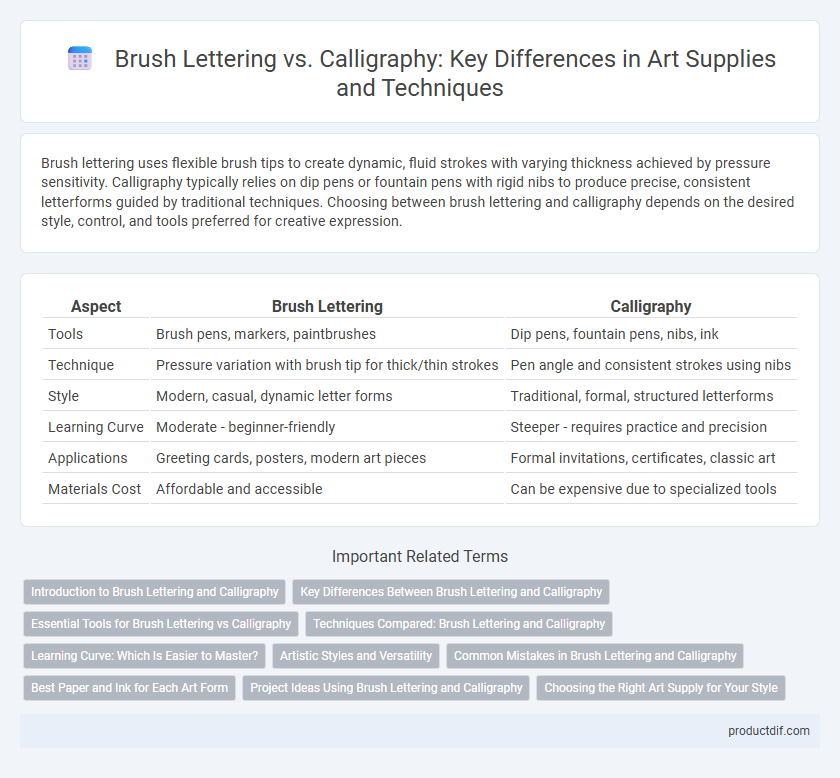Brush lettering uses flexible brush tips to create dynamic, fluid strokes with varying thickness achieved by pressure sensitivity. Calligraphy typically relies on dip pens or fountain pens with rigid nibs to produce precise, consistent letterforms guided by traditional techniques. Choosing between brush lettering and calligraphy depends on the desired style, control, and tools preferred for creative expression.
Table of Comparison
| Aspect | Brush Lettering | Calligraphy |
|---|---|---|
| Tools | Brush pens, markers, paintbrushes | Dip pens, fountain pens, nibs, ink |
| Technique | Pressure variation with brush tip for thick/thin strokes | Pen angle and consistent strokes using nibs |
| Style | Modern, casual, dynamic letter forms | Traditional, formal, structured letterforms |
| Learning Curve | Moderate - beginner-friendly | Steeper - requires practice and precision |
| Applications | Greeting cards, posters, modern art pieces | Formal invitations, certificates, classic art |
| Materials Cost | Affordable and accessible | Can be expensive due to specialized tools |
Introduction to Brush Lettering and Calligraphy
Brush lettering uses flexible brush pens or paintbrushes to create expressive, varied line thicknesses by adjusting pressure, offering a modern, artistic style. Calligraphy traditionally employs dip pens or nibs and ink to form structured letterforms following formal scripts and precise strokes. Both disciplines require practice and skill but cater to different aesthetic preferences and techniques in creating decorative handwriting.
Key Differences Between Brush Lettering and Calligraphy
Brush lettering uses flexible, synthetic or natural bristle brushes that create varied line thickness through pressure sensitivity, while calligraphy traditionally employs dip pens or fountain pens with nibs that produce strokes based on angle and consistency. The technique in brush lettering emphasizes fluid, dynamic strokes and often allows more creative freedom, whereas calligraphy follows structured, disciplined letterforms governed by specific historical scripts. Key differences also include the tools used, stroke variation methods, and the overall artistic style, with brush lettering trending in modern design and calligraphy rooted in classical traditions.
Essential Tools for Brush Lettering vs Calligraphy
Essential tools for brush lettering include flexible brush pens, watercolor brushes, and smooth, bleed-proof paper designed to handle ink flow and pressure variations. Calligraphy requires rigid nib pens, ink pots, and textured parchment or calligraphy paper specifically crafted to control ink absorption and stroke precision. Mastery in both arts depends on selecting materials that support the unique techniques and styles of brush lettering or traditional calligraphy.
Techniques Compared: Brush Lettering and Calligraphy
Brush lettering employs flexible brush pens or paintbrushes that create thick and thin strokes through pressure variation, emphasizing fluid, expressive lines. Calligraphy relies on structured nibs or dip pens with consistent ink flow, focusing on precise, formal letterforms with controlled angle and rhythm. Both techniques require mastery of stroke direction and spacing but differ in tools and stylistic approach to creating elegant letter shapes.
Learning Curve: Which Is Easier to Master?
Brush lettering features flexible brush pens that allow for intuitive strokes, making it more accessible for beginners to grasp basic shapes and styles quickly. Calligraphy demands precise control of traditional tools such as dip pens, requiring extensive practice to perfect letterforms and consistent pressure. The learning curve for brush lettering is generally gentler, while calligraphy offers greater complexity and depth, appealing to those seeking advanced mastery.
Artistic Styles and Versatility
Brush lettering offers fluid, expressive strokes ideal for modern and casual designs, while calligraphy emphasizes precise, structured forms suited for traditional and formal projects. Brush lettering tools, often flexible brush pens or markers, provide greater versatility across various surfaces and styles. Calligraphy requires specialized nibs and inks to achieve its classic elegance, making it more technique-specific but perfect for intricate script work.
Common Mistakes in Brush Lettering and Calligraphy
Common mistakes in brush lettering include inconsistent pressure application, resulting in uneven strokes, and improper brush angle that affects line variation. Calligraphy errors often stem from incorrect pen grip, leading to shaky lines, and neglecting proper stroke order which disrupts letter flow. Both art forms require steady hand control and practice to master the balance between thick and thin lines for elegant lettering.
Best Paper and Ink for Each Art Form
Brush lettering thrives on smooth, heavyweight, bleed-proof paper such as marker paper or Bristol board to ensure clean, vibrant strokes, paired with water-based brush pens or flexible brush markers for dynamic line variation. Calligraphy requires high-quality, smooth, and durable paper like hot-pressed watercolor paper or vellum to withstand repeated ink applications, typically using traditional calligraphy inks such as sumi or iron gall for crisp, consistent lines. Selecting the right combination of paper texture and ink type is crucial to achieving optimal results and preserving the integrity of each distinctive lettering style.
Project Ideas Using Brush Lettering and Calligraphy
Project ideas using brush lettering include creating personalized greeting cards, custom wall art, and decorative journal covers that showcase fluid and expressive strokes. Calligraphy projects often focus on formal invitations, certificates, and elegant place cards featuring precise, consistent letterforms. Both techniques enhance art supplies with unique visual appeal, suitable for DIY crafts, event decorations, and personalized gifts.
Choosing the Right Art Supply for Your Style
Brush lettering requires flexible, soft-bristled brushes or brush pens that allow dynamic stroke variation, while calligraphy demands firm, pointed nibs or broad-edged pens for precise, consistent lines. Selecting high-quality, pigment-based inks or waterproof markers enhances durability and vibrancy for both styles. Understanding your preferred technique and stroke control will guide you to choose tools that complement your unique artistic expression and improve your lettering skills.
Brush Lettering vs Calligraphy Infographic

 productdif.com
productdif.com